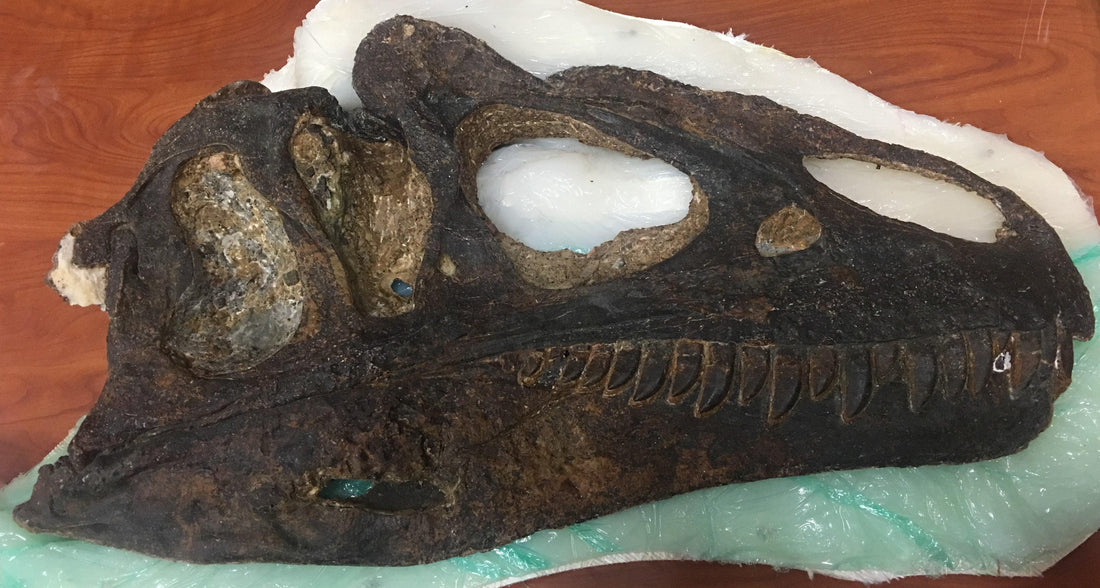
Allosaurus fragilis, one of the largest Late Jurassic Carnivores!
Share

Allosaurus fragilis - one of the largest Late Jurassic Carnivores!
Allosaurus fragilis is one of the best-known dinosaurs thanks to the huge number of fossils excavated of this Late Jurassic predator. Probable eggs, small juveniles, and numerous adult skeletons have been excavated all across the western United States. Essentially every bone is known for Allosaurus. Discoveries like “Big Al”, so named not because it was big (it actually was only 87% the average size), but rather because it was a “big” find as it contained 95% of the skeleton and “Big Al Two”, an even better specimen, are exceptionally important in helping paleontologists predict the size of a dinosaur.
Dozens of fragmentary Allosaurus skeletons have been uncovered throughout the Late Jurassic rocks (aka the Morrison Formation) of western North America. The most famous, and productive, Allosaurus quarry has been the Cleveland-Lloyd Dinosaur Quarry. The Cleveland-Lloyd quarry appears to have been a predator trap, possibly comprised of sticky mud, that a big herbivorous sauropod like Apatosaurus became mired in, it’s cries of frustration bringing in numerous Allosaurus thinking they would have an easy meal, only to themselves become stuck. The Cleveland-Lloyd skeletons, though mostly jumbled and incomplete, represent at least 45 Allosaurus individual specimens. Having this many individuals from one locale enables paleontologists to determine an average size. When doing so they refer back to complete specimens like “Big Al” to determine various ratios between bones, like the length of the femur to the tibia and fibula (all leg bones), to allow prediction of the size of animals that aren’t known from a complete skeleton. Much careful work over the last 25 years has gone into Allosaurus, determining the average size of an adult is around 28’ long and roughly 2,000 lbs. However, there be giants in the Morrison Formation…
In 1878 E. D. Cope, one of the legendary 19th-century dinosaur paleontologists, named Epanterias amplexus, or “clasping buttressed vertebrae”, from 5 bones: 1 dorsal (back) vertebra, 2 cervical (neck) vertebrae, 1 coracoid (part of the shoulder complex), and 1 toe bone. In the late 1800s Cope was in feverish competition with his arch-rival O. C. Marsh, and neither spent too much time analyzing fossils before naming them in publications. The size of the vertebrae led Cope to believe they belonged to a new genus of sauropod (the long-necked, long-tailed Jurassic giants) similar to Camarasaurus, a dinosaur he had named the year prior.
In 1921 Osborn and Mook determined that, other than being 20% larger, the bones of Epanterias were indistinguishable from Allosaurus, a conclusion agreed with by a group of paleontologists in 2004, who proposed Epanterias is simply a gigantic Allosaurus fragilis. By assigning the Epanterias bones to Allosaurus this increases the upper size range for Allosaurus to 39’ long and around 3 tons, substantially increasing the size of Allosaurus and making it much larger than the general perception of it traditionally is.
Allosaurus was recently in the news when research published in 2020 by Drumheller and colleagues suggested Allosaurus resorted to cannibalism! This was based on the presence of Allosaurus tooth markings on many Allosaurus bones from the Mygatt-Moore Quarry. Interestingly, they discovered one bite mark that suggested a *very* large animal, one larger than any known Allosaurus, Ceratosaurus, Saurophaganax, or Torvosaurus was scavenging on Allosaurus. They suggested it could belong to an unusually large Allosaurus (maybe even a new species), a large version of the other listed taxa, or a new giant theropod that lurked in the Morrison! I prefer to think the tooth bite belongs to a giant-sized Allosaurus, but I’m partial to the big guy.
Thank you kindly,
BC
Click here to see the Fossil Crates Allosaurus collection